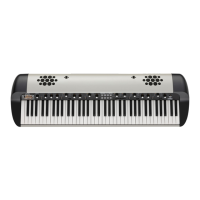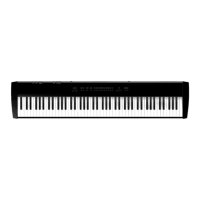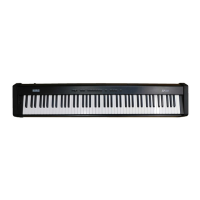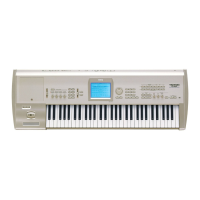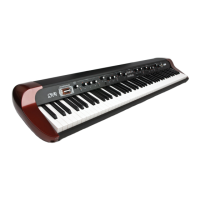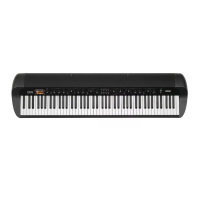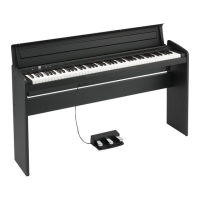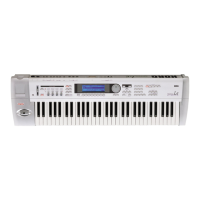57
Controllers / MIDI
Momentary
Operating a wheel or slider will transmit the corresponding MIDI data (VALUE data).
When the switch of a wheel or slider is moved, the SW VALUE will be transmitted, and when it is
released the FIX VALUE will be transmitted. The switch LED will be lit as long as you continue pressing
the switch.
For an assignable switch, pressing the switch will transmit the SW VALUE, and releasing it will transmit
the FIX VALUE.
FIX VALUE setting
Each controller function (TYPE) has a fixed value. This value cannot be modified. (Refer to the tables on
p.58 and following.)
This value will be used when either Alternate or Momentary is selected as the control method (MODE).
Lower limit (L) and upper limit (H) settings for a controller
• Use the 〈CURSOR〉 switches to move to the next screen,
and set the lower limit and upper limit of the values which
will be transmitted by that wheel or slider, etc. The avail-
able range will depend on the function (TYPE) that is
assigned.
The assignable switches (AS) do not have these settings.
The VALUE settings (low limit and high limit) will be set to the default values for the respective controller each time
you change the controller TYPE.
SW VALUE setting for switch operations
• Use the 〈CURSOR〉 switches to move to the next screen,
and specify the SW value which will be transmitted when
you operate the switch (switch) for that controller.
The assignable pedal (AP) does not have this setting.
The SW VALUE setting will be set to the default SW value for the respective controller each time you change the
controller TYPE.
Here we will give an example of how to set A.SLIDER1 〈AL1〉 to Master Balance.
Procedure
1) In Global mode or Program Edit mode, press select switch 9.
2) Use the 〈VALUE〉 slider to select “A.SLIDER1.” (You can also select this by moving A.SLIDER1.)
3) Use the 〈CURSOR〉 switches to select the next screen. Make the function in the lower line of the LCD
blink.
4) Use the 〈VALUE〉 switches (or slider) to select “Master Balance.”
5) Use the 〈CURSOR〉 switches to move to the next screen. “Mode:...” will blink.
6) Use the 〈VALUE〉 switches (or slider) to select “Mode: Slider Value.”
7) Use the 〈CURSOR〉 switches to move to the next screen. “L:...” will blink.
8) Use the 〈VALUE〉 switches (or slider) to select “L:L8192”
9) Use the 〈CURSOR〉 switches to select “H:...” and make it blink.
10)Use the 〈VALUE〉 switches (or slider) to specify “H:R8191”
11)Use the 〈CURSOR〉 switches to move to the next screen. “SW Val:...” will blink.
12)Use the 〈VALUE〉 switches (or slider) to specify “SW Val:R8191”
With these completed settings, the 〈AL1〉 of the SGproX will control the output balance of the device con-
nected to MIDI OUT.
The following three tables show controller settings separately for external control (Individual), sets of messages
for external control (Set), and for controlling the SGproX itself (Internal). When you make this setting, the
selections will be displayed in the order of Individual, Set, and Internal.
Lower limit
Upper limit
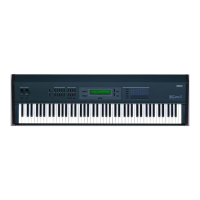
